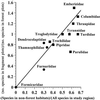Disappearance of insectivorous birds from tropical forest fragments
- PMID: 11782549
- PMCID: PMC117549
- DOI: 10.1073/pnas.012616199
Disappearance of insectivorous birds from tropical forest fragments
Abstract
Determining the impact of forest disturbance and fragmentation on tropical biotas is a central goal of conservation biology. Among tropical forest birds, understory insectivores are particularly sensitive to habitat disturbance and fragmentation, despite their relatively small sizes and freedom from hunting pressure. Why these birds are especially vulnerable to fragmentation is not known. Our data indicate that the best determinant of the persistence of understory insectivorous birds in small fragments is the ability to disperse through deforested countryside habitats. This finding contradicts our initial hypothesis that the decline of insectivorous birds in forest fragments is caused by impoverished invertebrate prey base in fragments. Although we observed significantly fewer insectivorous birds in smaller fragments, extensive sampling of invertebrate communities (106,082 individuals) and avian diets (of 735 birds) revealed no important differences between large and small fragments. Neither habitat specificity nor drier fragment microclimates seemed critical. Bird species that were less affected by forest fragmentation were, in general, those that used the deforested countryside more, and we suggest that the key to their conservation will be found there.
Figures



References
-
- Stouffer P C, Bierregaard R O. Ecology. 1995;76:2429–2445.
-
- Canaday C. Biol Conserv. 1996;77:63–77.
-
- Stratford J A, Stouffer P C. Conserv Biol. 1999;16:1416–1423.
-
- Kattan G H, Alvarez-Lopez H, Giraldo M. Conserv Biol. 1994;8:138–146.
-
- Thiollay J M. Conserv Biol. 1992;6:47–63.
Publication types
MeSH terms
LinkOut - more resources
Full Text Sources

